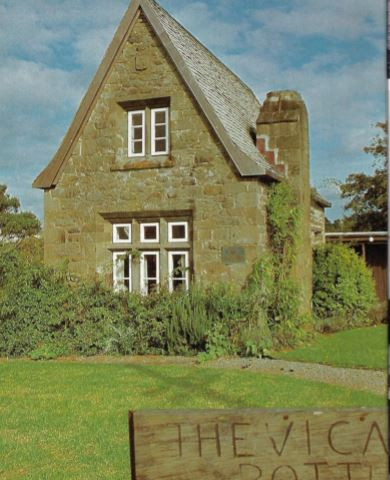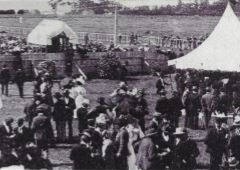13:2
The racecourse has been the venue of many social (and business) activities other than racing and trotting, including rugby, soccer, hockey and athletics. For several years, following the sale of the Agricultural and Pastoral Society's showgrounds at Waiwakaiho, it was the scene for annual A & P shows, and many thousands enjoyed the two days when the country visited the town to show off some of the country's best farming stock. In 1979 work started on a large complex, including a new enclosed stand, improvements to the track and the provision of grounds for athletics and other sports.
Rugby Park, in Westown, New Plymouth, is regarded by many as one of the finest sporting arenas in New Zealand. An (almost) natural amphitheatre, with Mt Egmont as a backdrop, it has been the venue for cycling meetings, band displays, a military tattoo, softball, travelling outdoor shows and a variety of other entertainments. But as its name implies it is primarily a rugby park. Owned and maintained by the Taranaki Rugby Union, it has, since its formation in the 1930s, been the scene of all grades of club, representative and international matches, often with crowds of more than 30,000 spectators. The game in New Plymouth owes its origin to R. J. Matthews. When he arrived in New Plymouth in October, 1873, he brought with him a reputation as a fine half-back, having represented Auckland, Wellington and Thames. He found no facilities in New Plymouth, but plenty of enthusiasm. The lads of the settlement were using a 'ball' made from a bullock's bladder, encased in a heavy leather cover, which they kicked about with little skill and less knowledge of what rugby was all about. Matthews sent for a rugby ball from Auckland, and with help from such \ prominent citizens as his life-time friend, historian W. H. Skinner, Truby King, J. Honeyfield, R. J. Collins (later Auditor-General) and Newton King, formed the Taranaki Rugby Club on January 28, 1874.4 The new club faced at least two major difficulties: lack of knowledge of the game, and opponents. The first was dealt with by Matthews, A. Drew, and W. Cook who had Australian training, and in less than three weeks there were enough young men with sufficient knowledge of the rudiments of the game to seek a challenger. This was forthcoming: 'The game of football seems to have become quite a favourite means of recreation with the youth of this town>, for it is only a short time since that the Taranaki Club was formed, and now we have another called the Egmont Club, which has shown its precocity by sending a challenge to its predecessor to playa friendly match ... ' Teams for this historic match were: Taranaki: R. J. Matthews
(captain), A. Drew, W. Cook, D. G. Draper, R. J. Collins, N. King, L. M. Donoghue, W. Moon, C. Moon, J. Russell, F. King, W. G. Chilman, W. H. Skinner, S. Curtis and T. Russell. Egmont: Stretch, Kelly, May, A. Gilmour, C. Gilmour, G. Gilmour, Whitten, Adams, M. D. King, . Cameron, Ibbotson, Hughes, Cock, Birch, Grey and Bleasel. The match took place on Poverty Flat on Tuesday, March 31, and 'most of the town's twelve hundred inhabitants" were present. Each team had two three-quarters, two halves and a fullback; the rest of the team were forwards. Players wore knickerbockers with a buckle where the stockings met the trousers, a guernsey and a cap. No sprigs were allowed in boots and any player found wearing a toecap was prohibited. There were no set serums. The penalty for an infringement was a free kick. In this and subsequent matches there was no referee 'for the simple reason that anyone who knew anything about the game was needed as a participant' . The method of scoring (soon to be changed, as it has been many times) was haifa point for a 'force-down' and four points for a 'try at goal'. Play started at three o'clock and 'the ball was brought home' at half past five, with Taranaki the victors by three 'force-downs' to nil. The following month a town v country match was played, with the Taranaki club emerging the victors, and in May the two clubs combined to form the first 'representative' team, which played against Patea, Wanganui and Hawera teams. Pioneers of inter-provincial rugby were an Auckland fifteen who toured the country in 1875. This tour enabled the game to 'survive the determined effort by a certain section of the press and public to kill the sport in this country on the grounds that it was dangerous, cruel and fit only for barbarians,' said the Herald. The Aucklanders arrived by the steamer Taupo at 8.30 a.m. on September 28, 1875, from Nelson, after a 'strenuous but not victorious tour of the South". Two of its members were former Taranaki club players-William Woon and F. O. Sharland. The town declared a holiday for the occasion. Government offices, banks and stores were all closed. Play at Poverty Flat began at 11.15 a.m.-less than three hours after the Auckland team landed-and finished at 1.15 with Taranaki the winners, 9];2 points to 1 point. The steamer left for Auckland at 3 p.m. after due celebration. The Canterbury team on tour the following year arrived off N gamotu, but was unable to come ashore because of the bad weather. Five men from Hawera and Patea had ridden more than 100 kilometres to play in this game. In August, 1877, the Otago team, travelling to Auckland, landed at Ngamotu and spent the day on shore but refused to play because they wanted to keep themselves in trim for the northern engagement. Matthews wrote: 'They were ashore all day and practised on our ground,
and even then they would not play. Great indignation expressed by the townspeople. Had a scratch match in the afternoon; a rather rough game.t" Meanwhile, Matthews had moved to Waitara. During his three years in New Plymouth he had established himself as a great half-back 'almost impossible to catch'. One of the reasons for this, perhaps, was that instead of the guernsey worn by the other players he had a tightly-fitting canvas jacket made 'which he used to soak in water, wring, and don it before taking the field ... more than one good fellow clutched (at him) missed and swore'. No doubt such unorthodox 'armour' also provided defence against Poverty Flat's built-in hostility. It was that block of land between Central School and the education board offices. 'As Liardet Street and Gover Street were not formed at that time, the ground was suitable regarding its length, but the width was not quite so good, as on one side was Pendarves Street, a grass lane, while on the other was a gully through which the railway afterwards ran, and it was a huge gorse brake. This proved at times very annoying as the ball was frequently being kicked into it, with the result that it occasionally lost its buoyancy owing to the penetrating power of the gorse pricks ... eventually Poverty Flat became unplayable owing to the inroads of rat-tail.'? Thomas Pole Hughson, who served in the Armed Constabulary, records in his diary!" that in 1880 his commanding officer was a Major Goring, 'a keen sportsman who played tennis, football, hockey, rugby and cricket whenever possible. When playing rugby against the Major we were accustomed to tackle him with some circumspection. I well recall how on one occasion he was opposed by a wild Irishman, Mick Mullineaux, who, being a recent arrival, was not aware of the unwritten rule and gave his commanding officer a somewhat rough handling. "That's not playing the game", said the Major later. After that Mullineaux played the game more tenderly when the circumstances seemed to warrant it.' By 1885 there were five senior rugby clubs in Taranaki-Waitara, Taranaki, Hawera, Waimate and Patea-and in that year the province's first representative team, named Egmont was beaten by Wellington and won against Hawke's Bay. In 1888 Lilywhite and Shrewsbury'S team of English players was defeated on the racecourse. This game put Taranaki rugby on the map and led to the establishment the following year of the Taranaki Rugby Union at a meeting in Hawera. There are four senior rugby clubs in New Plymouth, the oldest of which is Star, formed in 1889. Originally the Red House Club (named after the inn near the paddock on which they played) the name was changed because 'it was inapt for the young club to call itself after a hotel'.
They found opponents among the high school and Central schoolboys, and they, too, played on Poverty Flat, the racecourse, Sanders Park and school grounds until they were able to obtain their own land and gymnasium. Star's traditional opponent has always been Tukapa, a club which was formed in 1892 and which, five years later, won the senior champion- ship. Their home ground was the "Tukapa Paddock' which later became Sanders Park. Here in 1927 a dressing shed was built which, for many years after the pavilion was erected in 1932, housed the groundsmen's equipment. Tukapa has produced many fine players, among them Charlie Brown who, between 1902 and 1922, represented Taranaki and later became one of the club's most valuable coaches. The club's first All Black was Don Watson (1896), since when many other players have earned this honour, including Jack Sullivan, who became chairman and a life member of the New Zealand Rugby Football Union. The New Plymouth High School Old Boys began its career in 1919, and this club, too, has supplied its quota to All Black sides. These have included H. W. Brown in 1924, and his son Ross from 1955 to 1959. This club was without an official ground until 1960 when its present pavilion was opened at Vogeltown Park. The youngest senior club is Spotswood Old Boys, established in the late 1960s. It had problems in acquiring a home ground until the old Cook Street rubbish dump was abandoned, filled in, and grassed. Spotswood Old Boys built a pavilion there, it was renamed Marfell Park, and provides a useful sporting addition to this area in Upper Westown. Although each club possessed its own ground the need for a 'rugby headquarters' became apparent and in 1928 lY2ha of land in lower Westown was bought by the rugby union from the Standish Estate for $2800, following failed negotiations with the Tukapa club for lease of its ground at Sanders Park. This was the future Rugby Park, part of which was used as a golf course-the rest more suitable for trailbike riding than rugby-and work on it began in 1931. By May 1937 the first club game was played there, and in July the first international match, Taranaki versus South Africa, resulted in the Springboks winning, 13-7. Lack of money delayed further development. The park was offered to the borough council in 1945, an offer which was 'laid upon the table'. But in 1947, as a result of help from most Taranaki clubs and the public's response to a queen carnival, the union's debts were redeemed. The Star club opened its new pavilion on the western end of the park as part of the city's war memorial, the land and building being vested in the city council. In 1951 the gift of more land from the Star and Tukapa clubs enabled four more full-sized rugby fields to be added to the complex; two of them known as 'Star Field' and Tukapa Field' with touchline flags bearing these two clubs' colours. A further addition to the park's facilities was a new covered stand in 1965.

